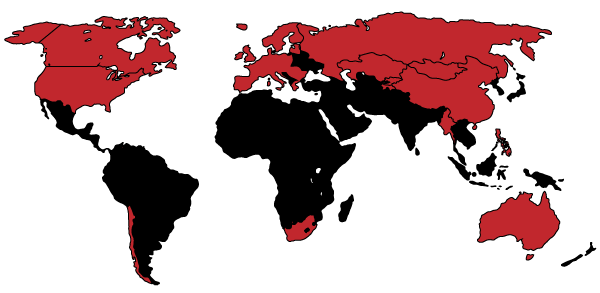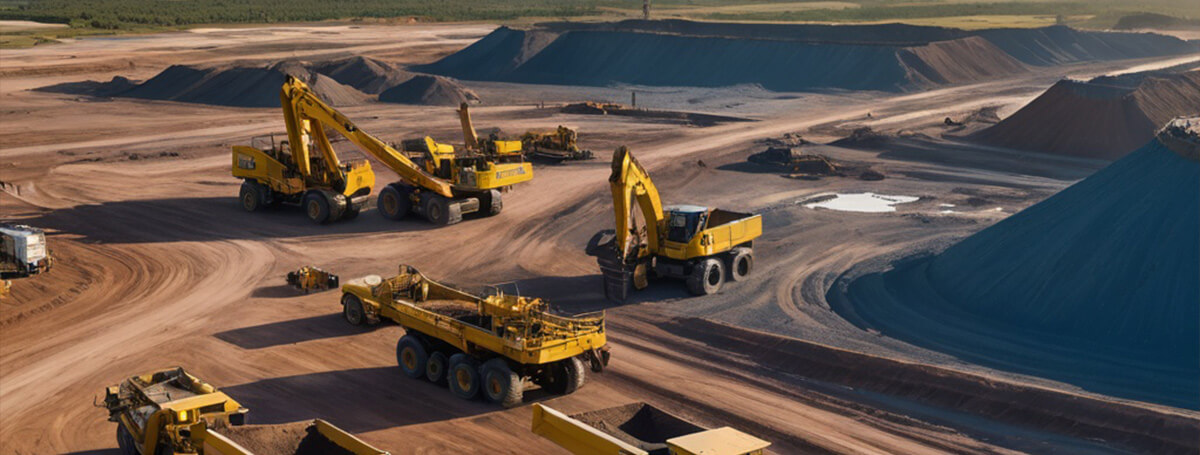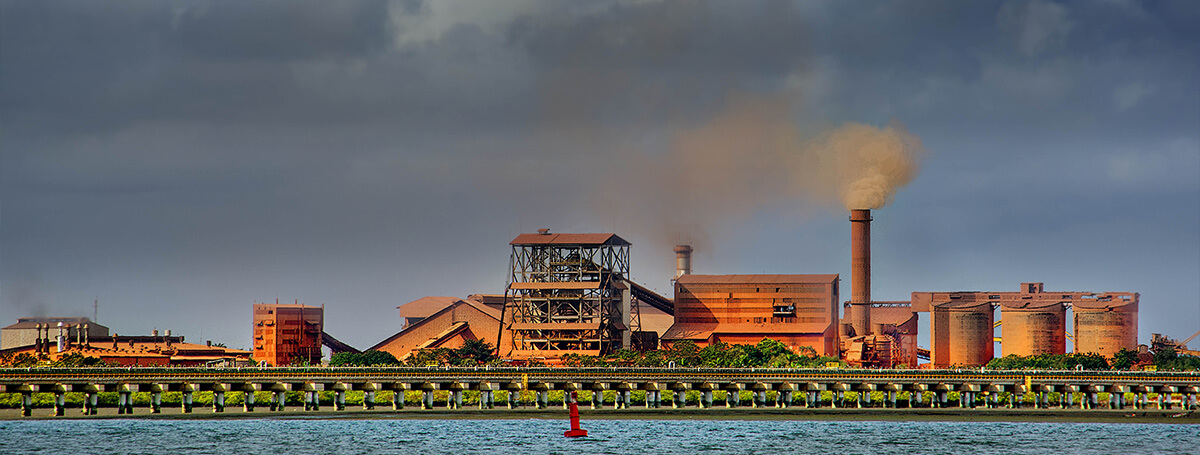

Australia
Australia is the world’s third largest supplier of iron ore, supplying 342 million metric tonnes in 2008.
Code:
Key Mining Legislation:
Queensland – Mineral Resources Act 1989
New South Wales Mining Act 1992
South Australia – Mining Act 1971
Western Australia Mining Act 1978
Tasmanian Resources and Development Act 1995
Northern Territory of Australia – Mining Management Act
Minerals Resource Rent Tax Act 2012
Useful Links:
The Department of Resources, Energy and Tourism (Resources Section)
New South Wales Division of Resources and Energy
Government of Western Australia Department of Mines and Petroleum
Northern Territory Government Department of Mines and Energy
CANADA
Canada is the world’s largest exporter of minerals and metals.
Code:
NI 43-101
Key Mining Legislation:
Northwest Territories and Nunavut Mining Regulations
British Columbia Mines Act 1996
Alberta Mines and Minerals Act
The Mines and Minerals Act Manitoba
Nova Scotia Mineral Resources Regulations
Useful Links:
The Mining Association of Canada
Saskatchewan Mining Association
Government of New Brunswick – Minerals and Petroleum
There is no one “Canadian Mining Law”. Mining is largely provincial and territorial jurisdiction, so there are effectively 13 different laws. Coal, uranium, and quarries all have separate and different laws from metal mining.
Canada’s legal structure relies on four kinds of law: criminal law, constitutional law, administrative law, and civil law.
Aboriginal rights and title issues are part of the constitutional law of Canada, and are found in specific Supreme Court decisions: Delgamuukw, Sparrow, the Haida/Taku case. These cases restrict the rights of the Crown and mining companies on traditional Indigenous lands, and assign a “fiduciary responsibility” to the Crown to protect the rights and interests of Aboriginal people.
Chile
In past years, Chile has produced 35% of the world’s mined copper and is home to the world’s largest copper mine.
Code
Code for the Certification of Exploration Prospects, Mineral Resources and Reserves
National Mining Legislation
Chapter III Constitution of the Republic of Chile
Constitutional Organic Law of Mining
State Ownership and Mineral Rights
Useful Links
The State has absolute, exclusive, inalienable and imprescriptible ownership of all mines, including natural guano deposits, metal bearing sands, salt deposits, coal and hydrocarbon deposits and fields and other fossil substances except surface clays, regardless of property rights of natural or legal individuals over lands wherein they may be found.
CHINA
China is the one of the world’s leading producers of aluminIum, antimony, barite, bismuth, cement, coal, fluorspar, gold graphite, iron and steel, lead, magnesium, mercury, molybdenum, phosphate rock, rare earths, salt, talc, tin, tungsten and zinc. It is also one of the largest exporters of antimony, barite, fluorspar, graphite, indium, rare earths and tungsten. Approximately 92% of China’s primary energy is derived from mineral resources.
Code
The Mineral Resource/Reserve and classification system of the PRC is in the process of being revised to be more in-line with international standards. The most recent minerals classifications published in China are illustrated here. The new code is expected to incorporate many aspects of CRIRSCO template.
Key Mining Legislation
Mineral Resources Law of the PRC
Catalogue for Guidance of Foreign Investment in Industry
China’s Policy on Mineral Resources (2003)
Useful Links
Chinamining.org sponsored by the China Mining Association
Ministry of Commerce People’s Republic of ChinaThe Central People’s Government of the People’s Republic of China
MYANMAR
Myanmar is endowed with world-class mineral resources including copper, gold, lead, zinc, silver, tin and nickel. High prospectivity and a lack of exploration means there is a high probability of further world class discoveries and the potential for high returns for mineral companies willing to commit to Myanmar.
Myanmar is one of the world’s oldest oil producers. It is estimated to have huge oil and gas reserves, however few fields are currently producing and most deposits remain unexplored. According to the Ministry of Energy the country’s proven reserves in 2012 stood at 2.1 billion barrels of oil and 25 trillion cubic feet of natural gas, most of that offshore.
Code
No national code at present.
Key Mining Legislation
The Myanmar Mines Law No.8/94 (the “Mining Laws”)
Ministry of Mines Notification No.125/96 (the “Mining Rules”)
Foreign Investment Law No. 21 / 2012
Union of Myanmar Notification No. 1/2013
Ministry of National Planning and Economic Development Notification No.11/2013 (“Investment Rules”)
European Union
There were 20,700 mining enterprises operating in the EU in 2006.
Code
Pan-European Reserves and Resources Reporting Committee (“PERC”)
PERC is the European equivalent of the Australasian JORC in Australasia, SAMREC in South Africa, and similar reserves standards bodies in the USA, Canada, and Chile, and with them is a constituent member of the Committee for (Mineral) Reserves International Reporting Standards (“CRIRSCO”)
National Mining Legislation
Europe is set to impose mandatory transparency measures for mining and forestry companies, requiring them to detail their financial relationships with foreign governments. The EU legislation, however, does not contain a general regulation of mining as such, nor on mining safety. As there is no such thing as a common EU mining legislation, each member state specific legislation is of importance to govern mining safety standards in the EU.
Useful Links
European Association of Mining Industries, Metal Ores & Industrial Minerals
Kazakhstan
In 2004, the mineral extraction sector accounted for 32% of Kazakhstan’s GDP.
Code:
Kazakhstan’s classification system for resources and reserves quite different from recognized international systems such as Australia’s JORC Code and N1 43-101. Kazakhstan still uses the former Soviet system which categorizes minerals according to which they have been explored and substantiated (A, B, C1, C2 and P1, P2, P3) on an economic value basis: e.g. “balance reserves” (commercial reserves) and “off balance” (lacking commercial potential). Reserves are subject to approval by the State Reserves Commission without which extraction cannot be started.
National Mining Legislation:
Law on Subsoil and Subsoil Use (no. 2828) (1996)
Useful Links:
E&MJ Engineering and Mining Journal – Kazakhstan Mining
Guiding Case Law:
Kazakhstan has a civil law system, similar to other CIS countries, with its foundation in the Constitution. Numerous applicable codes, laws and regulations, include: Civil Code, Tax Code, Land Code, Environmental Code, Competition Law, National Security Law, Investment Law, various Edicts, Resolutions, Decrees, Orders , New Tax Code (2009), new Mineral Extraction Tax – replaced royalties, increased tax burden on extractive sectors (tax base, rates).
Kyrgyzstan
All of the 554 tonnes of metallic mercury produced by Kyrgyzstan in 2000 was exported to China.
Code
National Mining Legislation
Law on Subsoil (July 2, 1997)
Law on Concession and Foreign Concessionary Enterprises in Kyrgyzstan (March 6, 1992)
Law on Production-Sharing Agreements (April 10, 2002)
Law on Coal (February 3, 1999)
Law on Oil and Gas (June 8, 1998)
Useful Links
Mining Industry and Sustainable Development in Kyrgyzstan
Information about the President of Kyrgyz Republic, Parliament, Government, Ministries (in Russian)
Kyrgyzstan Development Gateway
State tax inspection of Kyrgyz Republic
All mineral resources including metallic minerals are owned by the state except widespread common mineral resources (mortar sand, limestone, gravel, etc).
The right to use subsoil may be granted by issuance of a license to use subsoil, by concession, and on the basis of an agreement on production sharing in subsoil use. Individual placer miners obtain mining rights through registration with local state administration authorities.
A licence may be issued to an individual or legal entity of Kyrgyzstan or another country on a tender basis if the right to use a deposit of national importance is granted under it; for all other purposes, licences are issued by direct negotiations between the prospective licensee and the Ministry.
There are exploration licences, mining licences and licences for construction and operation of subsurface structures not related to mineral resources mining. The government grants concessions through a competitive process. The production sharing agreements are negotiated and executed by the government on the basis of outcomes of auctions and competitions.
Government Mining Agencies
The Ministry of Natural Resources is the main regulatory authority, which issues licences and executes licence agreements
Philippines
Philippines is the fifth most mineral-rich country in the world for gold, nickel, copper, and chromite. It is home to the largest copper-gold deposit in the world. The Mines and Geosciences Bureau has estimated that the country has an estimated $840 billion worth of untapped mineral wealth.
Code:
Philippine Mining Reporting Code (“PMRC”)
National Mining Legislation:
Useful Links:
Mines and Geosciences Bureau of the Philippines
The Chamber of Mines of the Philippines
All mineral resources in public and private lands within the territory and exclusive economic zone of the Republic of the Philippines are owned by the State. The State is responsible for promoting rational exploration, development, utilization and conservation through the combined efforts of government and the private sector in order to enhance national growth in a way that effectively safeguards the environment and protect the rights of affected communities.
Mongolia
Almost all of Mongolia’s copper concentrates are exported to China and Russia.
Code:
The Mongolian State Professional Committee on Mineral Resources (“MSPCMR”) and the Committee for Mineral Reserves International Reporting Standards (“CRIRSCO”) have formed a joint working group to develop a Mongolian Code for Public Reporting Standard for Exploration Results, Mineral Resources and Mineral Reserves in Mongolia that is compliant with the CRIRSCO template.
National Mining Legislation:
2006 Minerals Law (replacing the 1997 Minerals Law)
Nuclear Energy Law 2009 (regulating uranium exploration, mining)
The intention of the mineral laws was to grant licences for exploration which would lead to excavation and production that would be beneficial to the licensee and the nation. In 1997 it led to a boom in the mineral industry with an expansion in foreign direct investment in coal copper, gold and uranium.
Government Mining Agencies:
Mineral Resources Authority of Mongolia a subordinate of Ministry of Mineral Resources and Energy
Department of Geological and Mining Cadastre (grants exploration licences)
Mongolia grants both exploration and mining rights through licences, all areas open to exploration other than reserves, special purpose territories, existing license areas, etc.
Useful Links:
Russia
Taken together Russia’s extractive industries constitute 33% of Russia’s GDP.
Code:
The NAEN Code for the Public Reporting of Exploration Results, Mineral Resources, Mineral Reserves
National Mining Legislation:
‘On Subsoil’, February 21, 1992 – Law of the Russian Federation No. 2395-I
‘On Procedures for Foreign Investments in Companies of Strategic Significance for National Defense and Security’, April 2008, which is a Federal Law amending ‘On Subsoil’ that imposes restrictions on foreign investors seeking to buy shares or acquire control over Russian companies that are deemed strategic
Useful Links:
Committee for Mineral Reserves International Reporting Standards
Mining updates available via the website of The Executive Branch of The Russian Government
E&MJ Engineering and Mining Journal – Mining in Russia
The Federal Ministry is the principal authority responsible for regulating the activities of the Russian mining sector. It grants (in conjunction with regional authorities) subsoil use licences and issues documents with respect to subsoil use procedures, controls the technical aspects of mineral deposit exploitation and determines the boundaries of mining allotments (which define the subsoil blocks from which natural resources forming the subject matter of any licence may be exclusively extracted). All activities of the State Mineral Reserves Commission, the Central Mineral Reserves Commission and the various territorial commissions conducting registration and expert examination of mineral reserves on behalf of the state fall within the jurisdiction of the Federal Ministry.
The State Mining and Industrial Inspectorate also plays an important part in the functioning of the Russian mining sector. Amongst other things, it issues instruments creating mining allocations and grants permits covering hazardous industrial production.
South Africa
South Africa is the world’s largest producer of chrome, manganese, platinum, vanadium and vermiculite.
Code:
Key Mining Legislation:
Mine Health and Safety Act 1996
Minerals and Petroleum Resources Development Act 2002
Useful Links:
South African Government Online
A Minerals and Mining Policy for South Africa Green Paper for public discussion
Under newly enacted legislation, mining companies will be able to dig only under government licence. The legislation brings South Africa’s mining industry in line with the laws of other major mining nations such as Australia and Canada.
Tajikistan
Tajikistan has over 400 explored mineral deposits, containing 70 types of minerals.
Code:
National Mining Legislation:
Law on Precious Metals and Stones
Useful Links:
Guiding Case Law:
In May 2001 Tajikistan increased state control over mining and trading of precious stones and metals in hopes of boosting the economy. Parliament amended the Law on Precious Metals and Stones on May 6 to give the state greater control over the country’s natural wealth and make it a priority in developing the economy. The law increases control over the accounting, production, storage and transportation of the country’s precious metals and stones.
United States
The US is a world leader in the production of many important mineral commodities, including copper, pig iron and uranium.
Code:
The United States’ reporting standard for the mining industry for securities purposes is contained in the Security and Exchange Commission’s (“SEC”) Industry Guide 7. It defines proven and probable Reserves using its own definitions, and prohibits the disclosure of quantitative estimates, for all mineralisation other than those two Reserve categories (though disclosure of Measured and Indicated Resources as quantitative mineralised material estimates is now informally allowed). Similarly, it restricts disclosure of value estimates to Reserves only, which SEC policy generally requires to be on an historic cost accounting basis. The SEC does not maintain a formal Competent or Qualified Person policy.
National Mining Legislation:
National Mining Act 1872 (This act declared all valuable mineral deposits in lands belonging to the United States to be free and open to exploration and purchase. This law provides citizens of the United States the opportunity to explore for, discover, and purchase certain valuable mineral deposits on public domain minerals.)
Surface Mining Control and Reclamation Act 1970s
Federal Land Policy and Management Act 1976
Office of Surface Mining regulates surface coal mining
Mine Safety and Health Administration regularly inspects coal mines
Other Laws Relevant to Mining:
National Historic Preservation Act (1966), which governs the preservation of historic properties throughout the United States.
Resource Conservation and Recovery Act (1976), which governs the control of hazardous waste
Useful Links:
United States Environmental Protection Agency
U.S. Department of the Interior Bureau of Land Management
United States Department of Labor – Mine Safety and Health Administration



